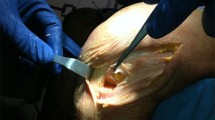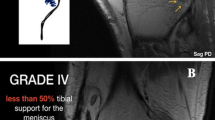Abstract
Purpose
The purpose of this study is to evaluate the kinematics changes of the knee after cutting of the ACL with or without injury of the anterolateral structures.
Methods
In this study, the role of the ACL and one of the secondary restraints in controlling knee stability using a navigation system was evaluated. The kinematics of the knee was evaluated in different conditions of instability: ACL intact, after dissection of the posterolateral (PL) bundle, after dissection of the anteromedial (AM) bundle, and after lesion of the lateral capsular ligament (LCL). Anterior tibial translation and rotation were measured with a computer navigation system in 10 fresh-frozen cadaveric knees by use of a manual maximum load. Anterior translation was evaluated at 30°, 60°, and 90° of flexion; rotation at 0°, 15°, 30°, 45°, 60°, and 90°.
Results
Cutting the PL bundle does not increase anterior translation and rotation of the knee. Cutting the AM bundle significantly increased the anteroposterior (AP) translation at 30° and 60° (P = 0.01), but does not increase rotation of the knee. Cutting the LCL increased anterior translation at 60° (P = 0.04) and rotation at 30°, 45°, and 60° (P = 0.03).
Conclusions
Within the testing conditions of this study, the PL bundle does not affect anterior translation and rotation of the knee; the AM bundle is the primary restraint of the anterior translation but does not affect rotation of the knee while the lesion of the LCL increases tibial rotation and could be related to the pivot shift phenomenon, so it is more correct and biomechanical valid to assess and repair the associated lesion of the antero-lateral structure of the knee at the time of ACL surgery.





Similar content being viewed by others
References
Bach BR, Tradonski S, Bojchuk J et al (1998) Arthroscopically assisted anterior cruciate ligament reconstruction using patellar tendon autografts: five-to nine-year follow-up evaluation. Am J Sports Med 26:20–29
Bellier G, Christel P, Colombet P et al (2004) Double-stranded hamstring graft for the anterior cruciate ligament reconstruction. Arthroscopy 20:890–894
Biau DJ, Tournoux C, Katsahian S et al (2007) ACL reconstruction: a meta-analysis of functional scores. Clin Orthop Relate Res 458:180–187
Campos JC, Ching CB, Lektrakul N et al (2001) Pathogenesis of the Segond fracture: anatomic and MR imaging evidence of an iliotibial tract or anterior oblique and avulsion. Radiology 219:381–386
Chouliaras V, Ristanis S, Moraiti C et al (2007) Effectiveness of reconstruction of the anterior cruciate ligament with quadrupled hamstrings and bone-patellar tendon-bone autografts. An in vivo study comparing tibial internal-external rotation. Am J Sports Med 35:189–196
Colombet P, Robinson J, Christel P et al (2007) Using navigation to measure rotation kinematics during ACL reconstruction: a cadaveric pilot study. Clin Orthop Relat Res 454:59–65
Colombet P, Robinson J, Jambou S et al (2006) Two-bundle, four-tunnel anterior cruciate ligament reconstruction. Knee Surg Sports Traumatol Arthrosc 14:629–636
DeLee JC, Riley MB, Rockwood CA Jr (1983) Acute posterolateral rotatory instability of the knee. Am J Sports Med 11:199–207
Ellison AE (1980) The pathogenesis and treatment of anterolateral rotatory instability. Clin Orthop Relat Res 147:51–55
Engebretsen L, Lew WD, Lewis JL et al (1990) The effect of iliotibial tenodesis on intraarticular graft forces and knee joint motion. Am J Sports Med 18:169–176
Ferretti A, Monaco E, Labianca L et al (2008) Double bundle anterior cruciate ligament reconstruction: a computer-assisted orthopaedic surgery study. Am J Sports Med 36:760–766
Ferretti A, Monaco E, Labianca L et al (2009) Double-bundle anterior cruciate ligament reconstruction. A comprehensive kinematic study using navigation. Am J Sports Med 378:1547–1553
Fukuda Y, Woo SL, Loh JC et al (2003) A quantitative analysis of valgus torque on the ACL: a human cadaveric study. J Orthop Res 21:1107–1112
Galway HR, MacIntosh DL (1980) The lateral pivot shift: a symptom and sign of anterior cruciate ligament insufficiency. Clin Orthop Relat Res 147:45–50
George MS, Dunn WR, Spindler KP (2006) Current concepts review: revision anterior cruciate ligament reconstruction. Am J Sports Med 34:2026–2037
Georgoulis AD, Papadonikolakis A, Papageorgiou CD et al (2003) Three-dimensional tibiofemoral kinematics of the anterior cruciate ligament-deficient and reconstructed knee during walking. Am J Sports Med 31:75–79
Gibson M, Mikosz R, Reider B et al (1986) Analysis of the Müller anterolateral femorotibial ligament reconstruction using a computerized knee model. Am J Sports Med 14:371–375
Gillquist J, Messner K (1999) Anterior cruciate ligament reconstruction and the long-term incidence of gonarthrosis. Sports Med 27:143–156
Hughston JC, Andrews JR, Cross MJ et al (1976) Classification of knee ligament instabilities. Part II. The lateral compartment. J Bone Joint Surg Am 58:173–179
Ishibashi Y, Tsuda E, Fukuda A et al (2008) Intraoperative biomechanical evaluation of anatomic anterior cruciate ligament reconstruction using a navigation system. Comparison of hamstring tendon and bone-patellar tendon-bone graft. Am J Sports Med 36:1903–1912
Ishibashi Y, Tsuda E, Tazawa K et al (2005) Intraoperative evaluation of the anatomical double-bundle anterior cruciate ligament reconstruction with the OrthoPilot navigation system. Orthopedics 28:S1277–S1282
Jakob RP, Hassler H, Staeubli HU (1981) Observations on rotatory instability of the lateral compartment of the knee. Experimental studies on the functional anatomy and the pathomechanism of the true and the reversed pivot shift sign. Acta Orthop Scand Suppl 191:1–32
Karlson JA, Steiner ME, Brown CH et al (1994) Anterior cruciate ligament reconstruction using gracilis and semitendinosus tendons: comparison of through-the-condyle and over-the-top graft placements. Am J Sports Med 22:659–666
Kocher MS, Steadman JR, Briggs KK et al (2004) Relationships between objective assessment of ligament stability and subjective assessment of symptoms and function after anterior cruciate ligament reconstruction. Am J Sports Med 32:629–634
Lane CG, Warren R, Pearle AD (2008) The pivot shift. J Am Acad Orthop Surg 16:679–688
Lopomo N, Bignozzi S, Nartelli S et al (2009) Reliability of a navigation system for intra-operative evaluation of antero-posterior knee joint laxity. Comput Biol Med 39:280–285
Mae T, Shino K, Miyama T et al (2001) Single-versus two-femoral socket anterior cruciate ligament reconstruction technique: biomechanical analysis using a robotic simulator. Arthroscopy 17:708–716
Monaco E, Labianca L, Ferretti A et al (2007) Double bundle or single bundle plus extra-articular tenodesis in ACL reconstruction? A CAOS study. Knee Surg Sports Traumatol Arthrosc 15:1168–1174
Noyes FR, Barber SD (1991) The effect of an extra-articular procedure on allograft reconstruction for chronic ruptures of the anterior cruciate ligament. J Bone Joint Surg Am 73:882–892
Palmer I (1938) On the injuries to the ligaments of the knee joint: a clinical study. Clin Orthop Relat Res 454:17–22
Pearle AD, Kendoff D, Musahl V et al (2009) The pivot-shift phenomenon during computer-assisted anterior cruciate ligament reconstruction. J Bone Joint Surg Am 91(Suppl 1):115–118
Pearle AD, Solomon DJ, Wanich T et al (2007) Reliability of navigated knee stability examination: a cadaveric evaluation. Am J Sports Med 35:1315–1320
Recondo JA, Salvador E, Villanùa JA et al (2000) Lateral stabilizing structures of the knee: functional anatomy and injuries assessed with MR imaging. Radiographics 20:S91–S102
Ristanis S, Stergiou N, Patras K et al (2005) Excessive tibial rotation during high-demand activities is not restored by anterior cruciate ligament reconstruction. Arthroscopy 21:1323–1329
Samuelson M, Draganich LF, Zhou X et al (1996) The effects of knee reconstruction on combined anterior cruciate ligament and anterolateral capsular deficiencies. Am J Sports Med 24:492–497
Slocum DB, James SL, Larson RL et al (1976) Clinical test for anterolateral rotatory instability of the knee. Clin Orthop Relat Res 118:63–69
Tashman S, Collon D, Anderson K et al (2004) Abnormal rotational knee motion during running after anterior cruciate ligament reconstruction. Am J Sports Med 32:975–983
Woo SL, Hollis JM, Adams DJ et al (1991) Tensile properties of the human femur-anterior cruciate ligament-tibia complex. The effects of specimen age and orientation. Am J Sports Med 19(3):217–225
Woo SL, Kanamori A, Zeminski J et al (2002) The effectiveness of reconstruction of the anterior cruciate ligament with hamstrings and patellar tendon. A cadaveric study comparing anterior tibial and rotational loads. J Bone Joint Surg Am 84:907–914
Wroble RR, Grood ES, Cummings JS et al (1993) The role of the lateral extraarticular restraints in the anterior cruciate ligament-deficient knee. Am J Sports Med 21:257–262
Yagi M, Wong EK, Kanamori A et al (2002) Biomechanical analysis of an anatomic anterior cruciate ligament reconstruction. Am J Sports Med 30:660–666
Author information
Authors and Affiliations
Corresponding author
Rights and permissions
About this article
Cite this article
Monaco, E., Ferretti, A., Labianca, L. et al. Navigated knee kinematics after cutting of the ACL and its secondary restraint. Knee Surg Sports Traumatol Arthrosc 20, 870–877 (2012). https://doi.org/10.1007/s00167-011-1640-8
Received:
Accepted:
Published:
Issue Date:
DOI: https://doi.org/10.1007/s00167-011-1640-8




